Master perfume dilution ratios by understanding the key concentration levels: Parfum (20-40%), EDP (15-20%), EDT (5-15%), and EDC (2-4%). You'll need precise measurements using professional tools like borosilicate beakers and digital scales. For a standard parfum, mix 20ml fragrance oils with 80ml alcohol, following a 2:1:1 ratio of base, heart, and top notes. Let your blend mature for best results—there's much more to discover about professional perfumery techniques.
Understanding Basic Perfume Concentration Levels
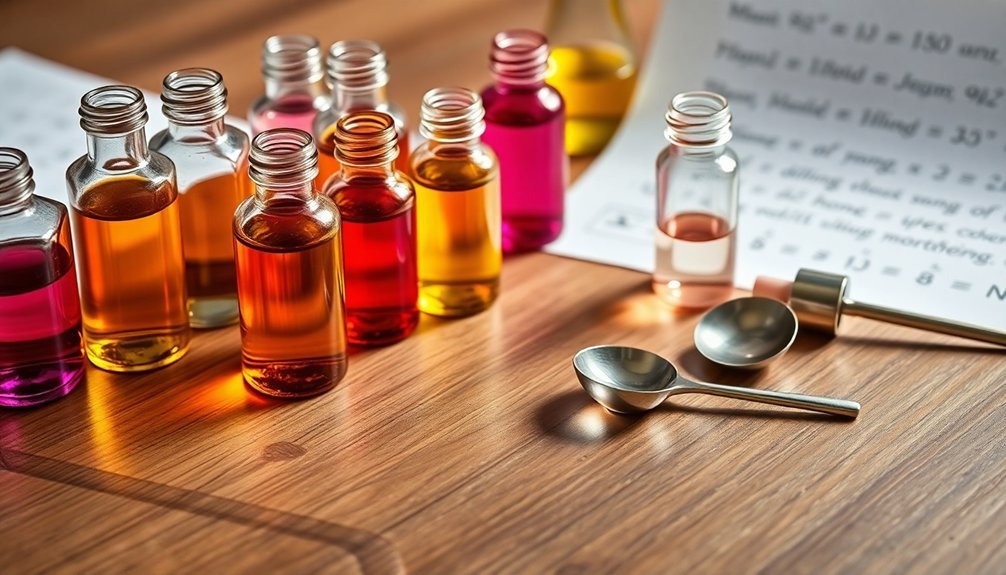
When you're exploring the world of fragrances, understanding perfume concentration levels is essential for making informed purchases.
At the highest level, you'll find Perfume Extract (Parfum) with 20-40% fragrance oil, lasting up to 24 hours and best suited for special occasions. This premium fragrance category demands the highest price point due to its concentrated formula.
Eau de Parfum (EDP) follows with 15-20% concentration, providing 6-8 hours of rich, complex scent.
For everyday wear, Eau de Toilette (EDT) offers a lighter option with 5-15% fragrance oil, lasting 3-4 hours. It's the most common type you'll encounter.
The lightest option is Eau de Cologne (EDC), containing just 2-4% fragrance oil.
With its invigorating citrus and herbal notes, EDC provides about 2 hours of wear, making it perfect for casual daily use.
Essential Tools and Measurements for Dilution
Before diving into perfume creation, you'll need a well-equipped workspace with precise measuring tools.
Start with borosilicate beakers for measurements and laboratory-grade droppers with Monprene bulbs to prevent evaporation and solvent damage.
You'll find a digital scale that measures to 0.00 grams essential for accurate weight-based dilutions.
Don't forget graduated pipettes for precise volume control and weighing spatulas for material transfer.
For mixing, you'll need a Teflon-bar mixer to avoid contamination.
Store your diluted materials in amber or cobalt blue bottles to protect them from light degradation.
Keep everything organized with clear labels, and maintain a clean workspace to prevent cross-contamination.
Remember to store your ingredients and dilutions in a cool, dark place for ideal preservation.
A stainless steel tray provides essential surface protection during your perfume pouring and filling processes.
The Science Behind Top, Middle, and Base Notes

When you're creating a perfume, you'll notice that different fragrance components evaporate at varying rates, with top notes dissipating within minutes while base notes can last for hours.
Understanding these evaporation rates helps you build a fragrance that unfolds beautifully over time, starting with fresh, volatile top notes and progressing through the heart notes to the lasting base notes. The complex floral ingredients within the mid notes serve as a crucial bridge between the fresh opening and warm base notes.
You'll achieve the best results by following standard perfume ratios: 20-40% top notes, 50-75% middle notes, and 5-10% base notes, ensuring your layers work in harmony throughout the fragrance's development.
Note Evaporation Rates Explained
Understanding fragrance notes and their evaporation rates is essential for appreciating how perfumes develop over time.
When you apply a fragrance, you'll first experience the top notes, which evaporate within 10-30 minutes. These volatile compounds create your initial impression with bright, fresh scents like citrus.
The middle notes emerge after about 15 minutes and can last several hours. They're less volatile than top notes and often feature floral or spicy elements that form the fragrance's heart.
Base notes, with their woody and musky characteristics, are the least volatile and provide lasting depth to your perfume.
Several factors influence these evaporation rates, including vapor pressure, molecular weight, and environmental conditions.
Airflow and humidity levels can markedly affect how quickly each note dissipates on your skin.
Balancing Fragrance Layer Harmony
The delicate art of balancing fragrance layers requires a scientific approach to create harmonious perfumes that evolve beautifully on your skin.
You'll need to master the proportions: top notes at 20-40%, middle notes at 50-75%, and base notes at 5-10% of your blend.
Your top notes will create that vital first impression, lasting 5-15 minutes with bright citrus elements. As these dissipate, your middle notes emerge, forming the fragrance's heart with floral or spicy components that last several hours.
Finally, your base notes anchor the composition with deep, enduring scents like sandalwood or musk.
To achieve perfect harmony, you'll want to use the drop-by-drop method, carefully considering how each note shifts into the next.
Think of your blend as a symphony where every component plays its essential role.
Professional Parfum (20%) Dilution Formulas
To create a professional Parfum concentration, you'll need to calculate 20 ml of fragrance oils per 100 ml of your final perfume.
Within those 20 ml of oils, you'll want to maintain a balanced ratio of 2:1:1 (base:heart:top notes), which translates to 10 ml base notes, 5 ml heart notes, and 5 ml top notes.
These precise measurements guarantee your fragrance maintains its intended character while achieving the proper strength expected in a Parfum-grade perfume.
Calculating Parfum Base Quantities
Creating professional parfum requires precise calculations of fragrance oil concentrations and base ingredients. For a 20% parfum concentration, you'll need to carefully measure your components to guarantee the correct ratios. In a 100ml batch, use 20ml of fragrance oil and 80ml of denatured alcohol.
To scale your formula, always maintain the 20% concentration while adjusting your base quantities. For example, in a 1000ml batch, you'll need 200ml of fragrance oil and 800ml of alcohol.
Start by mixing your fragrance oil with muscol and propylene glycol, then slowly incorporate the alcohol while stirring. Add deionized water gradually until you achieve the desired consistency.
Remember to let your parfum cure for several hours to allow proper blending of all ingredients.
Balancing Top-Heart-Base Notes
While mastering professional parfum creation requires precision, balancing the three note levels forms the foundation of a well-crafted fragrance.
Working with a 20% concentration, you'll need 20 drops of essential oils per 100 drops total, with the remaining 80 drops being your carrier oil.
For a harmonious blend, follow these key ratios:
- Top notes (20-40%): Use citrus oils like bergamot or lemon for that initial 5-15 minute impression
- Middle notes (50-75%): Include florals like lavender or rose to define the fragrance's core character
- Base notes (5-10%): Add depth with sandalwood or vetiver for lasting power
You can start with a basic 10-5-5 ratio (base-heart-top) and adjust according to your desired outcome.
Creating Eau De Parfum (15%) Blends
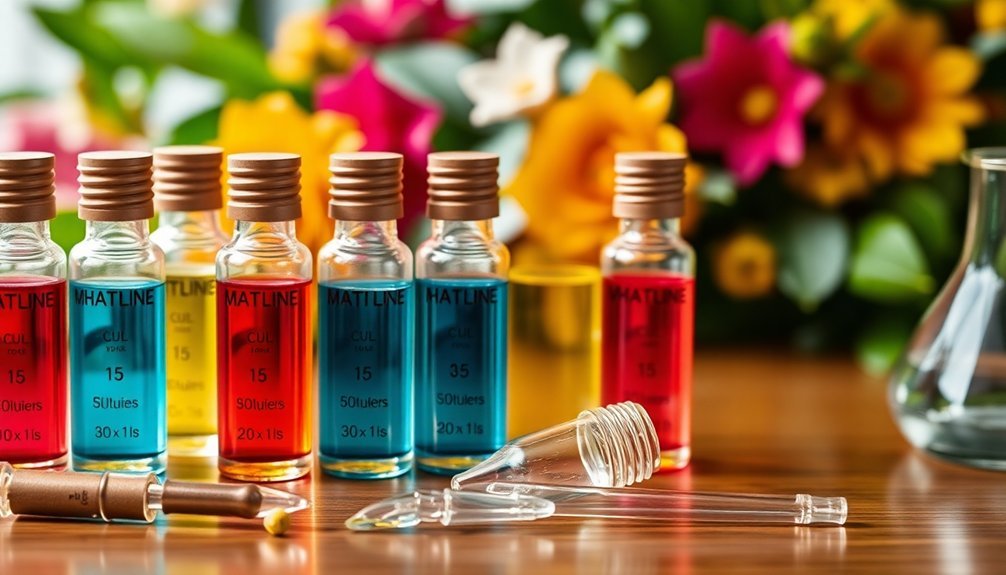
Whether you're an aspiring perfumer or experienced fragrance creator, making a 15% Eau de Parfum blend requires precise measurements and careful attention to detail.
For a 100ml EDP, you'll need 15ml of fragrance oils and 85ml of denatured alcohol.
Start by diluting your aroma chemicals and absolutes to 10% concentration for easier handling.
When mixing, add your fragrance oils gradually to the alcohol while stirring continuously. Don't exceed 10% if you're using essential oils instead of synthetic fragrances, as higher concentrations can cause skin reactions.
Store your blend in amber or cobalt blue bottles to protect it from light degradation.
Let your perfume mature for several weeks to achieve the best possible scent.
Always test your creation on a small skin area before full application.
Eau De Toilette (10%) Mixing Guidelines
Making an Eau de Toilette blend at 10% concentration requires precise measurements of both fragrance oils and alcohol. For a standard 100ml EDT preparation, you'll need exactly 10ml of fragrance oils and 90ml of alcohol carrier.
Using a properly calibrated scale and appropriate measuring tools like pipettes guarantees accuracy in your mixture.
To achieve consistent results in your EDT formulation:
- Tare your scale to zero before measuring each ingredient to maintain precise ratios
- Add your fragrance oils first, followed by the alcohol, to prevent quick evaporation
- Record all measurements in a spreadsheet or perfumery app for future reference
Don't forget to blend your mixture thoroughly to create a uniform concentration.
Store your finished EDT in an appropriate container that will preserve the integrity of your fragrance blend.
Eau De Cologne (5%) Recipe Calculations
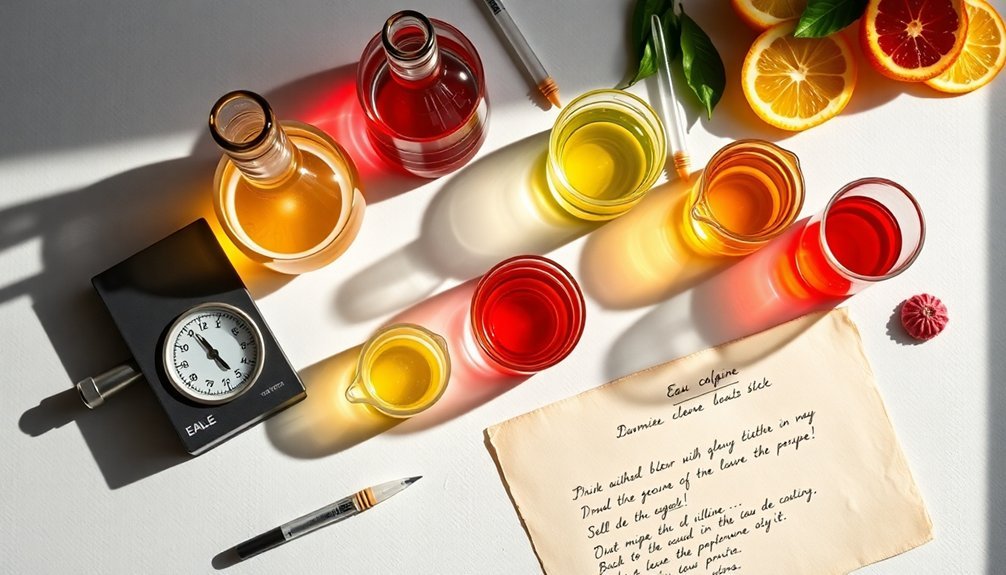
Since Eau de Cologne requires a lighter concentration than EDT, you'll need to adjust your measurements accordingly for a 5% blend. For a 100ml batch, measure 5ml of fragrance oils and 95ml of alcohol to achieve the perfect EDC ratio.
| Volume Size | Fragrance Oil (5%) | Alcohol (95%) |
|---|---|---|
| 50ml | 2.5ml | 47.5ml |
| 100ml | 5ml | 95ml |
| 200ml | 10ml | 190ml |
| 500ml | 25ml | 475ml |
| 1000ml | 50ml | 950ml |
You'll want to add the fragrance oils gradually to the alcohol while stirring continuously. Let your mixture mature for 2-3 weeks to allow the scents to blend properly. Remember to use clean, calibrated tools for precise measurements, and store your final creation in a sterilized bottle away from direct sunlight.
Aftershave and Light Fragrance Solutions
While Eau de Cologne offers a light, invigorating scent, aftershaves and light fragrance solutions require an even more careful approach to dilution.
Aftershaves typically contain 1-5% fragrance concentration in a carrier base of 70-90% alcohol, while light fragrances like Eau de Toilette maintain a 10% concentration standard.
You'll need to balance the carrier agents carefully, taking into account both evaporation rates and skin sensitivity.
Key factors to contemplate when creating these formulations:
- Aftershaves need lower concentrations to prevent skin irritation, often incorporating soothing ingredients like aloe vera or witch hazel
- Light fragrances require a higher proportion of top notes for immediate impact, while maintaining a balanced scent profile
- Both formulations must undergo safety testing to guarantee stability and skin compatibility
Advanced Weight-to-Weight Dilution Methods
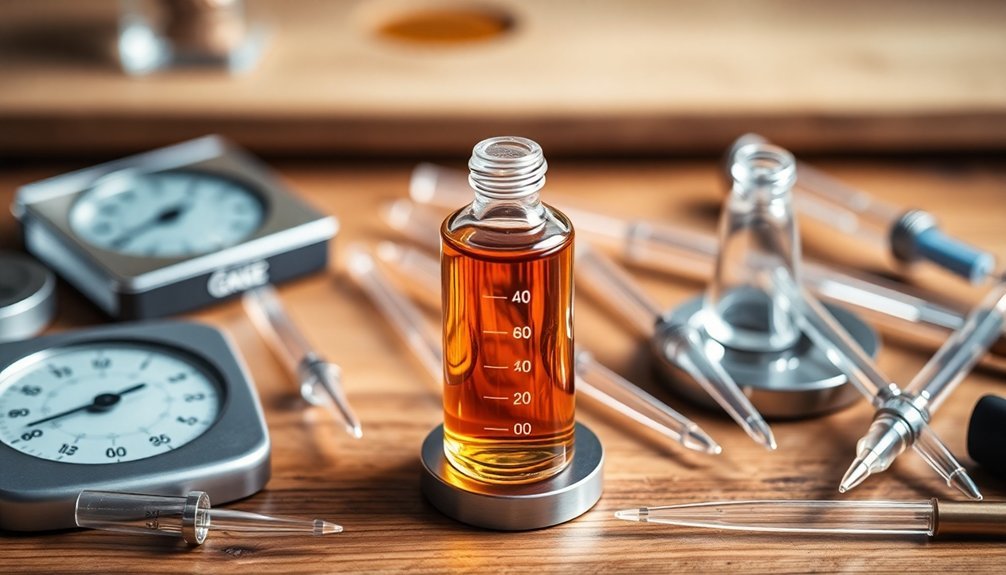
Weight-to-weight dilution methods represent the gold standard in professional perfumery. You'll need a precise scale and careful attention to detail to master this technique.
To create your dilution, first convert your desired concentration to a decimal. For example, if you're aiming for a 10% solution, you'll multiply your fragrance oil weight by 9 to determine the alcohol amount. If you're using 0.66 grams of oil, you'll need 5.94 grams of perfumer's alcohol.
Always reset your scale between measurements and use pipettes for precise liquid transfers. Don't rely on volume measurements, as they're less accurate than weight.
You'll want to document every step of your process, including exact weights and ratios. Remember to scrape any residual oils from your tools into the mixing container to maintain accuracy.
Frequently Asked Questions
How Long Should Perfume Oils Macerate Before Diluting With Alcohol?
You'll want to let your perfume oils blend together for 24-48 hours before adding alcohol. It's ideal to give them time to meld naturally, though you can start diluting immediately if needed.
Can Synthetic Fragrances Be Mixed With Natural Essential Oils?
Yes, you can mix synthetic fragrances with essential oils. You'll get enhanced scent throw and creative freedom in your blends. Just guarantee you're using proper dilution ratios and high-quality ingredients for best results.
What's the Shelf Life Difference Between Alcohol-Based Versus Oil-Based Dilutions?
Your oil-based perfumes will typically last longer than alcohol-based ones. While alcohol-based dilutions generally last 3-5 years, oil-based versions can remain stable for 5-10 years when you store them properly.
Do Weather Conditions Affect Perfume Dilution Ratios?
Yes, you'll need to adjust your dilution ratios in extreme weather. High temperatures and humidity can accelerate evaporation of alcohol-based perfumes, while cold weather may require stronger concentrations for maximum performance.
Why Do Some Perfumes Separate After Dilution and How to Prevent It?
Your perfume separates due to incompatible solvents, insufficient maturation, or incorrect dilution ratios. To prevent this, use proper solvents, allow adequate maturation time, and follow correct dilution ratios for each ingredient.
In Summary
You're now equipped with professional perfume dilution knowledge to create custom fragrances at any concentration level. From precise parfum ratios to light cologne blends, you've learned the essential calculations and techniques for mixing scents. Remember to maintain accurate measurements, respect the balance of fragrance notes, and always document your successful formulas. Start with simple dilutions and gradually work toward more complex blends.

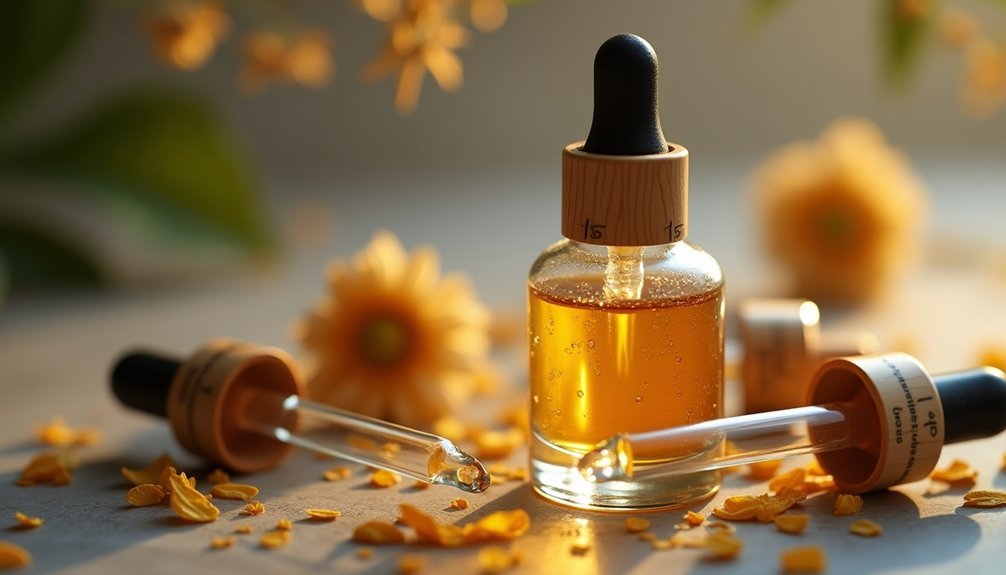



Leave a Reply